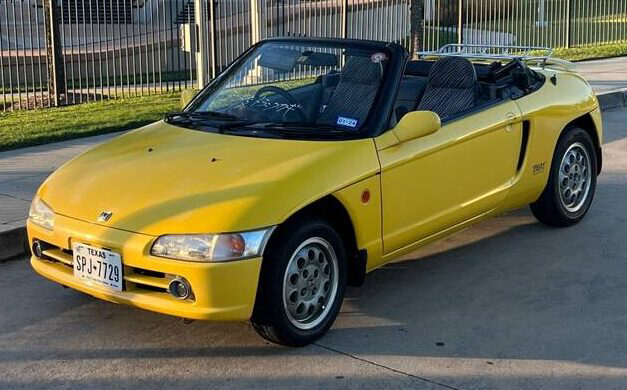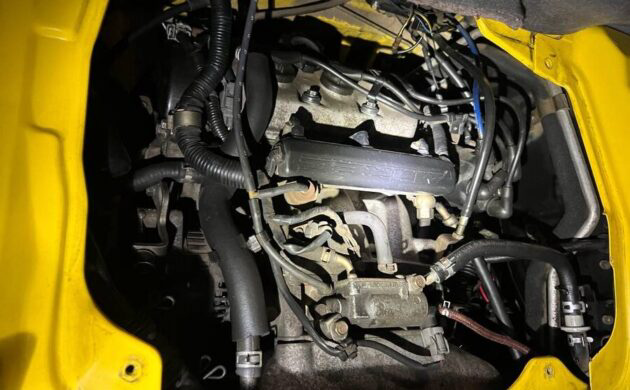Some classics are cool because they are achingly beautiful, while others achieve that status via mind-bending performance. This 1992 Honda Beat is cool simply because it isn’t asking to be taken seriously. It laughs in the face of life’s stresses, allowing its owner to wear a mile-wide smile. This beauty is a JDM import that presents well for its age. It has no pressing issues beyond needing a new home. Therefore, the seller has listed it here on Craigslist in Conroe, Texas. It could be yours for $6,500, and I must say a big thank you to Barn Finder PRA4SNW for spotting a seriously cool Japanese classic.
Honda introduced the Beat in 1991, with the car remaining in Japanese domestic production until 1996. It is historically significant because it was the last model approved by company founder Soichiro Honda before his passing in 1991. It features the tiny dimensions expected from any Kei Car, and this one is a private import. It is anything but subtle, with its panels sporting dazzling Yellow paint that guarantees that although it is small, it will stand out in a crowd. Its overall condition and presentation are good, with no significant panel or paint issues. There is no visible rust, and the seller doesn’t mention problems in their listing. The condition of the Black soft-top is unknown, but since it probably doesn’t get much of a workout in the current location, I would expect it to be in respectable shape. The plastic and other trim items are in good order. The luggage rack is practical since one medium-sized suitcase will fill the car’s minuscule trunk. The alloy wheels would benefit from a polish, and at least one center cap is missing. Overall, this Honda makes a positive first impression.
Many Kei Cars from this era featured tiny engines boosted by a turbocharger, but Honda’s successful history with technology like variable valve timing saw it decide to pursue the normally aspirated path with the Beat. Its mid-mounted 656cc three-cylinder engine benefits from Multi Throttle Responsive Engine Control (MTREC) technology to produce a respectable 63hp and 44 ft/lbs of torque. This feeds to the rear wheels via a five-speed manual transaxle, with the company (thankfully) not offering an automatic option. The Beat will hardly leave muscle cars trembling in their boots, but with only 1,675 lbs to shift, that sweet little engine can launch this classic through the ¼-mile in 18.9 seconds. Relatively short gearing means these cars work hard at freeway speeds, but the seller has made changes that should make a positive difference. They replaced the original cogs for fourth and fifth gear with different ratios. This gives the car longer legs, relieving engine strain as speeds climb. The car also recently received a new clutch kit, a slave cylinder, belts and hoses, a timing belt and gears, and new spark plugs. They don’t indicate how well this Honda runs or drives, but the indications are positive.
The first thing most readers will notice about this Beat’s interior is that this classic is right-hand drive. Honda produced the Beat for the Japanese domestic market, and no LHD version was made. However, adapting to the wheel on the “wrong” side is not difficult, and most enthusiasts will find it becomes second nature after a short drive. If the Beat’s exterior is extroverted, its interior serves up more of the same. It is trimmed in Gray, Black, and White. The seats feature zebra stripe patterned cloth that will divide opinion, with matching floor mats to complete the look. The remaining surfaces wear Gray plastic, which was typical Japanese fare from the era. The driver’s seat has wear and slight damage, and the new owner may need to fit slipcovers if they can’t locate replacement upholstery. Some plastic items are scuffed and marked, but I can’t spot any cracked or broken components. The driver’s view is dominated by a white-faced tach with a redline set at 8,100rpm, while occupants benefit from air conditioning, power windows, and an AM/FM stereo radio/cassette player with optional dash-mounted speakers.
This 1992 Honda Beat won’t appeal to everyone, but that is true of any classic. However, with Kei Cars enjoying a solid following, it is guaranteed we will have Barn Finds readers who view it as an automotive “must-have.” It has no urgent needs and appears to be a turnkey proposition that is undeniably affordable. Recent sales results indicate the price of this classic is highly competitive. If a classic guaranteed to plaster a mile-wide smile on your face is on your Wish List, this Beat deserves a close look.











Looks a fun little car.
I’ve always been envious of the Toyota Hilux offerings in other parts of the world. Also seen a cool Hyundai 4×4 the Galloper 🐎 i believe it was called, and some nice little Nissan rigs too.
Driving a RHD car is no big deal. The only difference is that you shift with your left hand, and if you go through a drive-through lane, you’ll want to do it in reverse. In my experience, the passenger seat is much more unsettling. I was grabbing for the nonexistent steering wheel and stomping on the phantom brake pedal the whole time.
Someone is about to have a lot of fun for not a lot of money.
Love these kei cars ever since I first heard about them. There’s a Suzuki Cappuccino I think that I’d really like to own. But hey, only room for one toy.
Yeah, ok…A. NO, buy a Ninja or a Busa or a CBR 1000 and leave this unit in Japan.
After driving one — in California, freeways and all — I’m a big fan. Picking up the RHD drill is simple, made easier because the Beat is so tiny. Except for shifting, it hardly seemed different.
But from what I’ve seen, buying a used JDM car is more chancy than it seems. It may be a flaw on the photo, but I think I see the beginnings of rust on the LH rocker panel. Cars DO rust in Japan. Kei cars also risk premature mechanical wear because first owners buzz the daylights out of those little engines. And, finally, there’s the parts issue. I simply don’t know how Beats are in that regard, but I’d want to be certain spares are out there before buying. And, worst of all, some states are now refusing to issue plates and titles for Kei cars.
Still, the price seems right, and these are about as much fun and attention-getting as anything short of taking up public nudism.
I often say “if I was a regular size guy” this would be fun. It would look like a clown car underneath me. Someone will enjoy the heck out of this.
On the positive side, when you pull up to valet parking, toss ’em the keys and tell’em to put it up on the shelf!
On the positive side, when you pull up to valet parking, toss ’em the keys and tell ’em to put it up on the shelf!
That’s assuming the valet can drive a stick-shift…
No need. Just tuck it under your arm.
Wow! I had no idea that Honda made these as early as ‘92. My 2001 Toyota Spyder looks like a knock-off. Knowing what I know about the Spyder, I would buy this car now if I didn’t already have one!
There is legislation coming to make kei cars illegal to register in the US. They’re going hard after the trucks & vans…
Mileage and any rust issues?
The epitome of no overhangs front & rear, where severe damage can be done to the drivetrain, suspension, & body with just minor impacts.